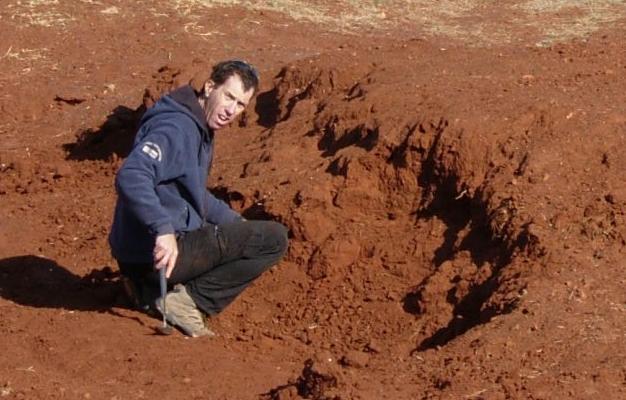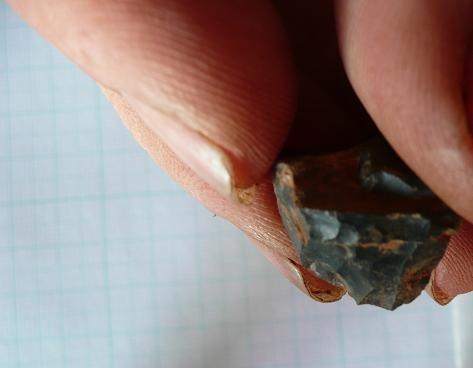The stone tools discovered by researchers from the Hebrew University in a cave in South Africa are the oldest evidence that humans lived in caves as early as 2 million years ago

Evidence of the world's oldest cave dwellers in the WONDERWERK cave in South Africa was recently revealed by researchers from the Hebrew University and other universities. The researchers from the Hebrew University, Prof. Hagai Ron and Dr. Ari Matmon from the Institute of Earth Sciences and Dr. Liora Kolska Horvitz, a fellow researcher at the Natural Sciences Collections, were part of an international research team led by Prof. Michael Hazan from the University of Toronto. The team also included Dr. Naomi Porat from the Israel Geological Survey and other researchers from South Africa and Canada.
Wonderwork Cave, a South African National Heritage Site, is an archaeological excavation site from the 40s. As part of the renewed research on the site, the team examined the lower level in the cave. At this level, small stone tools were found that were identified as belonging to the Oldowan culture, and were dated by the researchers to 2 million years. According to Dr. Horvitz, the geological and archaeological findings indicate that these tools were left in the cave after an activity on the spot and did not reach it by chance from the outside, for example as a result of a flood or landslide. These results indicate that primitive humans (homonins) lived in caves much earlier than previously thought.

Several species of hominins lived in South Africa 2 million years ago. The most suitable "candidate" for the production of the stone tools uncovered in the Wonderwork Cave is Homo-Habilis, who lived in Africa 1.7-2.5 million years ago.
Prof. Ron and Dr. Matmon from the Hebrew University used two advanced dating methods and thus determined with certainty the age of the level in which the Olduvan tools were discovered. The first test was conducted in the paleomagnetic laboratory of the Hebrew University in Jerusalem. For the purpose of the test, Prof. Ron used 50 sediment (soil) samples originating from different levels in the cave, including the lower level. With the help of the samples, he recorded reversals in the position of the Earth's magnetic pole, which today is in the north, but in the past there were changes in it in different periods. After such reversals were recorded in the laboratory in samples from Wunderwerk, this information was cross-referenced with the sequence of reversals in the Earth's magnetic field dating from the mid-Mesozoic (about 150 million years ago) to the present day to determine the age of the samples.
The second dating method was done by measuring the concentration of the rare atoms that are created as a result of interaction between cosmic radiation and atoms on the surface of the rock. For this purpose, Dr. Matmon prepared sediment samples from the cave, including from the lower level, for testing in the cosmogenic isotope laboratory, the establishment of which was completed a year ago at the Hebrew University. After preparation, the samples were sent to a laboratory in the USA where the isotope concentration was measured using a particle accelerator. From this concentration, Dr. Matmon calculated the age of the sample.
Both dating methods gave identical results indicating an age of 2 million years for the lower archaeological level at Vanderwerk. According to Prof. Ron and Dr. Matmon "the analysis of the age results gave an ambiguous result, which is relatively rare in studies of this type".
Dating of most ancient archaeological sites in East Africa is carried out by established methods, which rely on the dating of basalt layers and volcanic ash that provides information about the age of the findings. In the absence of suitable volcanic activity, these methods are not applicable at Vanderwerk. That's why Prof. Ron and Dr. Matmon had to look for new dating methods and find a way to combine them. The successful application of the two dating methods at Wonderwork can be a model for dating other sites in South Africa.
In addition, Prof. Ron and Dr. Matmon are working on developing additional methods at other prehistoric sites in Israel.

7 תגובות
To the question "What's wrong"?
Although many animals live in caves, no primate lives in caves. A primate who moved to live in a cave did so with a cultural change, not just a genetic change, just as a primate who started using fire, stone tools or a cell phone did.
Both dating methods gave identical results indicating an age of 2 million years for the lower archaeological level at Vanderwerk. According to Prof. Ron and Dr. Matmon "the analysis of the age results gave an ambiguous result, which is relatively rare in studies of this type".
?????
Maybe you mean "unambiguity"?
We are not talking about Homo sapiens, but Homo habilis.
------
my new blog - Another science
Homosapiens have existed for about 200,000 years, right? So how do we talk about 2 million here?
A pretty big exception.
and they use tools too?
There are hundreds of species that live in caves
I don't know about you, I don't see any tools.